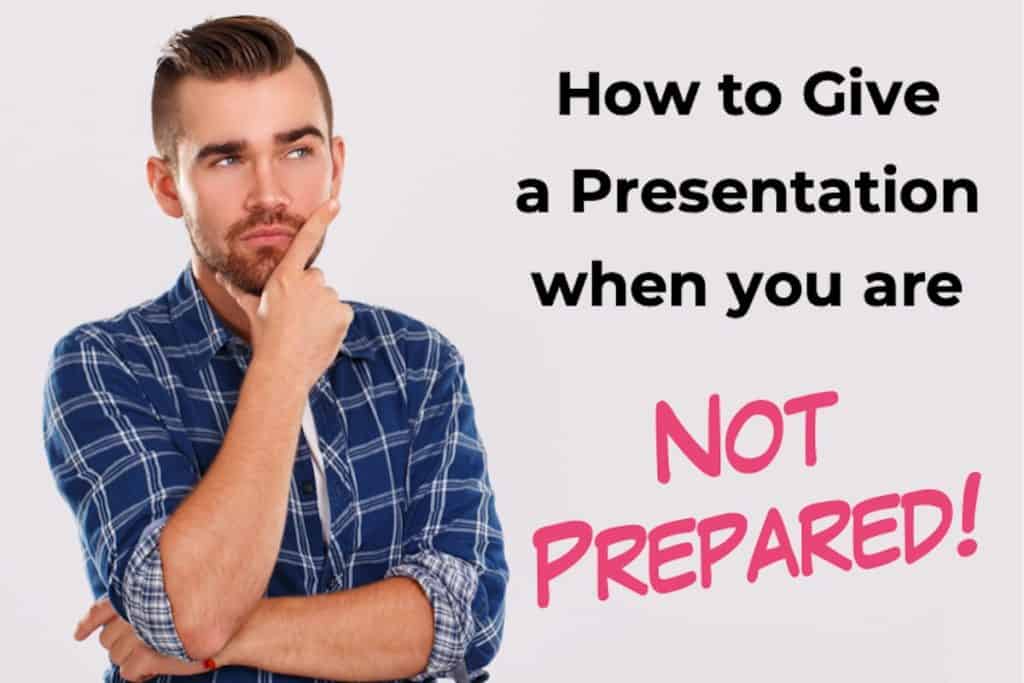
Presentations are a powerful way of conveying messages to your colleagues, employees, or even prospective clients. But, there are times when you have been given a really short notice and you just don’t have time to prepare for a presentation! So, what can you do in such situations and how should you give a presentation when you are not prepared for it?
If you are not prepared to give a presentation, start by calming yourself down. Jot down 3 to 5 points as key takeaways. Then, make a short presentation with images and one-line text. Speak slowly and allow audience participation. Remember – your audience doesn’t know that you are not prepared.
In this article, I will discuss everything you need to know about giving a presentation when unprepared. Tips that I’m sharing below are from my own personal experiences. It has worked for me, and I hope it does for you as well. So, keep reading!
Giving a Presentation when you are NOT Prepared!
Giving a presentation is not hard even when you are not prepared for it. But, it is the fear of failure, especially in front of others, that compounds the problem.
So, any time you are in a situation when you are not prepared for a presentation, remove the audience from the picture temporarily. Imagine that you have to explain the topic (that you have been assigned for the presentation) to a friend. What would you have said? How would you have explained to him or her?
Once you’ve got that soaked in, take a deep breath and try some of the following tips on how to give a presentation when you are not prepared!
1. Calm Yourself Down
Everything is a lot more difficult when you are flustered and in a rush. That is why calming yourself down just before giving your speech or presentation, will help you focus on all the next steps that we will talk about in the rest of this article.
Calming yourself down can be done quite easily, in fact, one of the best ways to do it is just to tell yourself to be calm. Tell yourself that the worst thing that can happen is not the end of the world and that you shouldn’t even worry about it because you know you are going to give the best presentation possible.
I know, I tried to make it seem easy. But, as I mentioned earlier, just take a few breaths and do what I mentioned above. It will surely help.
2. Focus on 3 to 5 Key Takeaways for your Audience
As mentioned earlier, think of how you would have explained the topic of your presentation to your colleague or a friend. Then, introspect and observe the points that you just thought of and make a note of these points. This will help you create an outline for your presentation.
Identify a few key takeaways for your audience. Then, using the outline you just arrived at, build up your talking points. Remember the 3 things that you want each of your point to convey –
- State your point
- Talk about the “why” of your point.
- Talk about what your point means. Share some anecdotal or personal experience.
- Depending on your type of presentation you can also include the “where”, the “consequence” and the “how” of your points.
Try and include the aforementioned structure for your talking points as this will help build your presentation.
3. Use Images and One Line Text
This trick is super helpful especially if you are short on time!
Okay, so let’s say that you have to give a presentation and you have to do it really quickly. You don’t have much time to prepare but you need to get it done. Well, making an image-based presentation can really do the trick for you.
Use a lot of images, possibly one on every slide. Then, with those images, include only one line of text. This should be the key point that you are trying to convey through that slide.
This allows you to do 2 things –
- Forces your audience to focus on you rather than read the text on the slides.
- Saves you time to create, write, and design the content for your presentation; thereby allowing you at least some time for practising the presentation!
Furthermore, this will also force you to keep your talking point short and precise and make your presentation look structured and professional.
Also, when you are not reading the text from the slides (which you perhaps would have otherwise done if there was more than one line of text on the slide), the presentation delivery feels natural and you will come across as a person who has indeed prepared for the presentation.
4. Speak Slowly
This kind of ties-in with being calm.
If you are flustered, you will find yourself talking very fast. This is one of the quickest ways to lose your audience’s attention and also a sure way to put yourself under more pressure.
From when you introduce yourself, you want to speak slowly and clearly. Speaking slowly will also give you enough time to think about what you are going to say next.
When I say speak slowly, I don’t want you to sound mentally challenged. What I mean is take enough pauses during your presentation. Don’t be afraid to take pauses in between sentences to recoup your thoughts while allowing your audience to soak all the information that you’ve just shared.
Trust me, if you do this right, the only thing that you will be doing is creating suspense within your audience. This means that they want to hear what you have to say next, even more, that’s actually a win-win for you.
5. Think Before you Say Something

Again, as with speaking slowly, take your time to formulate your sentences. Think about what you are going to say and then say it. If you make a mistake and you maybe mumble something, don’t shy away and don’t don’t cave in.
Instead of caving in, when you make a mistake, just rehash what you are going to say. You can do it like this “oh excuse me, what I meant was…” and then just carry on with your presentation. Your audience really will not mind a few fumbles as long as you stay calm.
This will also ensure that you don’t use filler words as those are a real mood-killer!
So, speak slowly and take a brief moment to think before you say something.
6. Keep all your Talking Points Short and to the Point
Keep all of your talking points short and precise. Stick to the point and do not venture off in your mind and start rambling on about random things. This is one of the easiest ways to tell if somebody is unprepared.
It is important to note that there is a difference between rambling on about something and including your audience and then responding to their thoughts and opinions.
When you do respond to the audience, that is not rambling on, they are just giving you talking points that help your presentation.
7. Look Carefully at Each Slide Before you Engage the Audience
When you aren’t prepared for a presentation, the last thing that you want to do is to start fumbling your words or having to look back at a slide multiple times. Look at each slide carefully to prevent any unwanted fumbles on your part.
If you don’t want the audience to know that you weren’t prepared, give them time to absorb everything on the slide. In reality, you are busy preparing your points for the slide and your audience is busy looking at the slide.
The audience might actually be grateful that you weren’t in a rush and you gave them the necessary time to fully understand your presentation.
8. Include the Audience by Allowing them to Participate

If you are unprepared to the point where you don’t really know what you are going to talk about and have to give the presentation on the fly, there is one trick that can help you. This is especially if you need to go past a certain amount of time.
Including the audience in your presentation will not only help you increase the length of your presentation but it has a number of benefits as well. Here are a few of those benefits.
- You will hold the attention of your audience for longer.
- They will understand the presentation better.
- You will be able to take some talking points away from your audience.
That is just a handful of relevant benefits.
Some of the ways you can include audience participation is by –
- Asking them questions or their opinion on certain key points of the presentation.
- Including a small activity that involves knowledge sharing and exchange of ideas such as a group discussion on a topic.
- Include an ice-breaker at the beginning of your presentation.
9. Share Anecdotal Experience Wherever Possible – Make it Personal
Sharing anecdotal experience makes your presentation unique. It gives the audience your perspective of a certain topic.
Storytelling is a great way of sharing your personal experience. You can include any personal experiences that are unique to the point or the message you are trying to convey with the specific slide. However, do make sure that it is linked with the presentation and the key point of the slide.
Personal experiences also keep the audience more engaged experience something that is unique which draws their attention towards you as a speaker. Little personal touches go a long way not only when giving a presentation but also when dealing with clients.
10. Remember, your Audience Doesn’t Know that you are NOT prepared!
It is important to remember that only YOU know that you haven’t been able to prepare. Your audience is not aware of that! So, as long as you don’t give away any hints of lack of preparedness, they are never going to find out that you aren’t prepared.
You can use any one or multiple tips mentioned above and trick the audience into believing that you are indeed prepared for the presentation.
Final Thoughts
Giving a presentation especially when you are not prepared doesn’t have to be that hard. Perhaps you may feel nervous the first time. It is absolutely normal. But, remember to stay calm and be confident. You surely will be able to deliver the presentation with great success.
Hopefully, this article has helped you, and I hope that you will not have to be nervous the next time you get caught off-guard. Remember to bookmark this page so that you do not forget anything.

![[Guide!] How To Give a Presentation When You are NOT Prepared?](https://artofpresentations.com/wp-content/uploads/2020/10/Featured-Image-How-to-Give-a-Presenation-When-you-are-Not-Prepared.jpg)